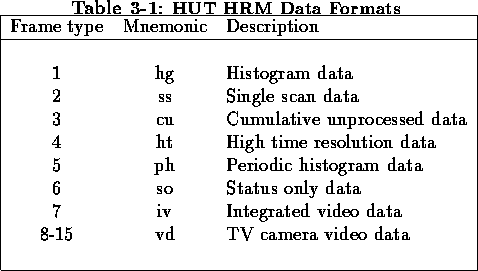
While a limited amount of HUT housekeeping information is downlinked in the data stream generated by the Spacelab EC, the full set of HUT engineering parameters and science data require a much higher bit rate. The DEP formats a variety of telemetry frames for transmission through one 97,656 bit per second HRM channel. There are 8 basic telemetry frame formats as summarized in Table 3-1.

The first six of these modes have a direct correspondence to the operational
mode of the SP.
During typical science observations, spectrograph data are transmitted either
in histogram mode, with a 2048 pixel cumulative spectrum downlinked
every 2 s, or in high time resolution mode. In high time resolution mode,
individual events are tagged by location (1 to 2048) and arrival time to
a precision of ![]() 1 ms. These frames are transmitted every 2 s.
Every 60 s in high time resolution mode a
cumulative histogram is transmitted as a periodic histogram frame.
This ensures that no data useful for producing a time-averaged spectrum
are lost even if data dropouts cause the loss of individual ht frames, or
high count rates prevent all events from being transmitted.
(Sources must have total count rates, including airglow, less than
1 ms. These frames are transmitted every 2 s.
Every 60 s in high time resolution mode a
cumulative histogram is transmitted as a periodic histogram frame.
This ensures that no data useful for producing a time-averaged spectrum
are lost even if data dropouts cause the loss of individual ht frames, or
high count rates prevent all events from being transmitted.
(Sources must have total count rates, including airglow, less than
![]() to prevent the buffers from overflowing
in high time resolution mode.)
to prevent the buffers from overflowing
in high time resolution mode.)
Single-scan and cumulative unprocessed data are used for detector diagnostics such as forming pulse-height distributions. Each of the science frame types (1-5) has an engineering status header. This status section is transmitted as a status-only frame every 2 s whenever the SP is hibernating (a self-test state used during South Atlantic Anomaly passages) or turned off, or whenever the detector is off.
Video frames from the HUT TV camera are transmitted as an eighth of a full frame every 2 s. Thus it takes 16 s to transmit one full video frame. These frames have intensities digitized to 4 bits, so they serve to identify stars, but they do not make spectacular astronomical images.
A higher dynamic range can be achieved by requesting a software video integrated picture. In this mode the DEP integrates a 16 bit image over a 43 × 53 pixel region around the center of the TV field of view for the requested integration time. This can be useful for identifying extremely faint targets.